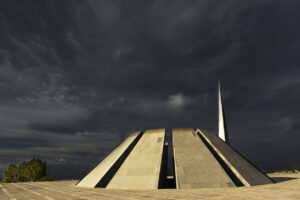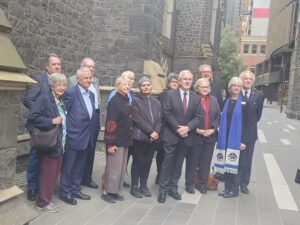
By Rhys Bezzant
14 January 2022
Have you seen that video where a man and a woman walk down a street at night, with a soundtrack of violins playing romantically? The music tells us that they are in love, they have enjoyed an evening of delight in each other’s company, and that all is right with the world. Then the same footage is replayed, but the musical backdrop is no longer orchestral harmony, but instead the screeching sound of string instruments performed not to reassure but to warn, as if danger lurks on the darkened street and we are about to witness a villainous attack. The musical soundtrack playing in the background changes our interpretation of the events unfolding before our eyes.
So it is with culture. The intellectual, or economic, or political currents of our age predispose us to see our world in a certain light. As Christians, we need to understand culture in order to grasp how it might be shaping us to misread the Scriptures, or alternatively how it might alert us to themes of the Scriptures which we had previously only half seen. With the help of theology, church history, and the people of God, we learn how to discern the strengths and weaknesses of the cultures of which we are a part.
Read more: I want to talk to my colleagues about Christianity, where do I start?
And the soundtrack to our lives and ministry – and the ministry of much of the 20th century – is known as Modernism, a cultural movement that emerged at the end of the 19th century and gained ground as the 20th century progressed. Note, however, Modernism is not the same as modernity, which more often is known as the Enlightenment. Unlike the Enlightenment, Modernism was not asserting what was universally true, nor was it trying to capture and describe the rules governing the universe. By contrast, Modernism assumed a world in which there were no universally binding rules, no order to acknowledge, no truth to proclaim. It was the job of each individual to create their own order by assertively shaping the fragmented, chaotic, and confusing world around them. The birth of Modernism in the 1880s and 1890s was a function of an age which witnessed the dangers of unbridled capitalism, the growth of mega-cities, mass migration enabled by mass transportation, the power of machines and industry to reshape society, and the categories of gender and race to create new kinds of attachment where there was only dislocation. Modernism was the cultural movement which reasserted the power of an individual’s self-expression to bring some measure of stability to a world falling apart, one in which there was no self-evident meaning.
But Modernism didn’t drop out of the sky. It built on ideas which upturned much of 19th century thinking. Reflecting themes from Darwin’s writing, Modernism recognised that cause and effect are not easy to trace in history, and certainly cause and effect do not follow any providential patterns. Highlighting the anthropology of Freud, Modernism believed that there were deep undercurrents of irrationality in each of us, which needed to find some kind of outlet. And admiring the audacity of Nietzsche, Modernism likewise refused to accept the supernatural and asserted the priority of the individual, and especially the individual’s will to power. Nietzsche’s nihilism came as a bolt from the blue, an explosive challenge to communitarian values and Romantic sensibility. Artists like Picasso or Kandinsky, novelists like Conrad or Proust, and poets like Yeats or Rilke turned their back on a world in which meaning was to be discovered as an objective given. They believed that meaning had to be invented starting with one’s own subjective insights. This was a fundamental philosophical and existential rupture. In her essay Mr Bennett and Mrs Brown, Virginia Woolf captured much of the Modernist spirit when she wrote so provocatively: “On or about December 1910 human nature changed.” William Butler Yeats, in The Second Coming, would later write with a sense of crisis: “Things fall apart; the centre cannot hold.”
Read more: Nicodemus’ struggles offer insight into what God’s love is like
This fundamentally new approach to the world was to have enormous impact on Christian ministry, beginning slowly but accelerating as the 20th century progressed. It became the background music for many initiatives and movements among Christians, which, though temporarily silenced by the noise of the First World War, picked up steam in the 1920s and 1930s, and found its way into the mainstream in the 1960s. Modernism gave permission to movements which prized disruption, like early Pentecostalism, and encouraged its vein of self-expression, most distinctly with the speaking of tongues. Modernism nurtured both Fundamentalism, with its ultimately militant aspiration towards separation, and the Social Gospel, with its muting of the transcendence of the Kingdom of God. Modernism explored new ways of binding people together when there was no inherent order in the universe, which was part of the appeal of Muscular Christianity beginning in the late 19th century, which championed manliness as a pathway to finding new alignments, new attachments and new agency in a world of anomie. Starting as a Broad Church movement in the Church of England, and being taken up by the evangelical wing of the church some time later, Muscular Christianity sponsored the foundations of the Salvation Army, the Boys’ Brigade, the codification of association football (“soccer”), and the invention of basketball.
Modernism prized bold leadership, on or off the sporting field. It demanded risk-taking, pursuing things that had never been done before. It was perfectly suited to the age of Empire, in which Europeans or North Americans found themselves in difficult locations overseas, harnessing their political or economic or theological motivations to the growth of “civilisation”. It emboldened women to seek suffrage at home, and encouraged missionaries to serve not just on the coast of countries where the gospel had arrived, but in the interior of those countries too, a much greater challenge requiring self-consciously consecrated, perhaps heroic, leadership. Both the Edinburgh Missionary Conference of 1910 and the Student Volunteer Movement under the leadership of John Mott challenged believers to push more valiantly to evangelise the world “in this generation.” Of course, lauding heroic individuals who could stand up to the ills of the age and provide powerful leadership to bring a sense of stability and order had disastrous consequences later in the 20th century. With philosophical justification and technological innovation, both fascist and communist dictators were to go on to wreak havoc in the Modernist century.
Read more: Delight in the days of simple joy
Modernism still exerts cultural influence in our own day, and Christian ministry must still navigate its strengths and weaknesses. Big cities, artifacts of Modernism with all their internationalism alongside fragmentation, spawn a yearning for a sense of connectedness, which the gospel can provide. In the last 30 years, church-planting in big cities all around the world has been a wonderful accommodation to modernist realities. On the other hand, while modernism values self-expression, the gospel teaches the value of self-denial. Finding the meaning of life is not the result of assertively creating order through exercise of the will, but rather we find life, Jesus teaches, when we die to ourselves to pursue his will and ways. Taking up our cross and denying ourselves to follow Christ is our calling under any kind of philosophical conditions, though it might be harder under Modernism. Indeed, leadership in the church must reflect this very posture: leaders are servants of the servants of the Lord, not those who demand allegiance or lord it over others in an attempt to create unity, which is after all a gift from the Spirit. All Christians, no matter their theological stripe, must negotiate their relationship with the culture around them, rejecting that which is inconsistent with biblical truth, and where it is consistent, using it as a bridge to communicate the gospel. We praise God that his revelation to us in the Scriptures and in his Son gives us points of leverage to discern how we might engage responsibly with the soundtrack of Modernism in order to magnify Christ, a soundtrack which can be identified with a singularly explosive note.
For on 26 August, 1883, a volcano on the Indonesian island of Krakatoa erupted, with worldwide impact. In a church service in Hamburg, Germany, a parishioner saw the chandeliers swaying from side to side, and wondered what on earth could have caused the movement, not thinking for a moment that it had its origins in faraway south-east Asia. The eruption produced ash clouds that changed climates, and its reporting became a media sensation in ways not seen before through the aid of modern technology. All over the world, volcanoes were the topic of conversation and sites of scientific inquiry. Having seen volcanoes on his travels, even William Guilfoyle, the creative mind behind Melbourne’s Royal Botanic Gardens, created one at the gardens’ highest point to represent the wonders of nature and – more importantly perhaps – to act as a reservoir to water the grounds. Serendipitously, the explosion at Krakatoa and the image of the volcano it popularised serve as a fitting picture to represent the Modernist moment and movement of the end of the 19th century. No longer able to contain the energy within but with no plan to use it constructively, the volcano exemplifies the primordial power of uninhibited expression, with its capacity to reshape the world, for good or for ill. We might be in thrall to Modernism, or merely aware of how to channel its cultural insights, but let’s not be unaware of its theological dangers as well. Ask Nietzsche who wrote: “God is dead. God remains dead. And we have killed him.”
The Reverend Canon Dr Rhys Bezzant is senior lecturer at Ridley College, and dean of the Anglican Institute.
This piece was updated on 16 January to reflect that the quotation “Things fall apart; the centre cannot hold“ is from The Second Coming, by William Butler Yeats.
For more faith news, follow The Melbourne Anglican on Facebook, Twitter, or subscribe to our weekly emails.







